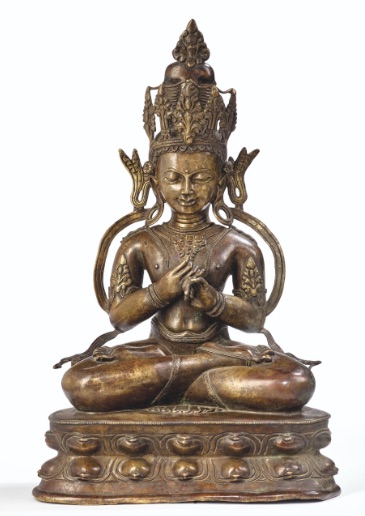1150-1250 AD, Tibet, Buddha Vairocana, brass, 46 cm, photo: courtesy of Ulrich von Schroeder, Buddhist Sculptures in Tibet Volume Two, Visual Dharma Publications, p. 1162 pl. 308A, at the rNam rgyal lha khang of the sNye thang (Nyethang) monastery, (Tibet).
While the other four direction buddhas always have their hands in the same position, there are various possibilities for Vairocana. This work depicts him with a buddha appearance and making the gesture of enlightenment (bodhyagri mudra) specific to him.
15th century, Tibet, Vairocana, bronze with stone inlay, 27,5 cm, private collection, Auction 19 lot 308, Hardt
In his one-head and two-arm form his hands may also display the ‘turning the wheel of dharma‘ gesture. The above, depicted in his sambhogayaka form (bodhisattva appearance) is seated on a lotus base with an unusually tall plinth, more often seen on much later works, and adorned with a singular celestial scarf, which appears to have one end flowing up and another dropping to his knees.
14th-15th century, Tibet, Vairocanabhisambhodi, brass, 47,4 cm, photo as before, p. 1158 pl. 306A, Potala Collection, Lima Lhakhang inventory nº 1026, Lhasa (Tibet).
Rarely seen in sculpture, there is a form of Vairocana with the same iconography as Amitayus, i.e. with both hands in the gesture of meditation, but without the vase of longevity. We saw one on HAR and another from the Gyantse kumbum on Huntington Archive.
Circa 14th century, Tibet, Sarvavid Vairocana, brass, 32 cm, photo: courtesy of Ulrich von Schroeder as above, p. 1155 pl. 304D, at the Ngor E wam Monastery (Tibet).
Vairocana with four heads and two arms, his hands cupped in the gesture of meditation to support an eight-spoke wheel or an upright vajra sceptre, a form also known as Sarvavid Mahavairocana.





































